In 2018 my husband Paul and I made the big move to Ireland from our previous home on a sheep property near Crookwell on the NSW southern tablelands. Accompanying us were our five sheep dogs. We purchased the large, rambling old Moyaliffe House (built in 1820) with 12 acres of grounds around it. And began a new business called Garden Tours of Ireland.
Included in the 12 acres was an old walled garden. This was the icing on the cake for me being a garden designer, and it sealed the deal. In July 2019 we moved into Moyaliffe House.
The last nine months have been challenging for everyone to say the least. Here in our new home in Co. Tipperary in south west Ireland it has been no different in many ways and not just because of the Covid 19 pandemic!
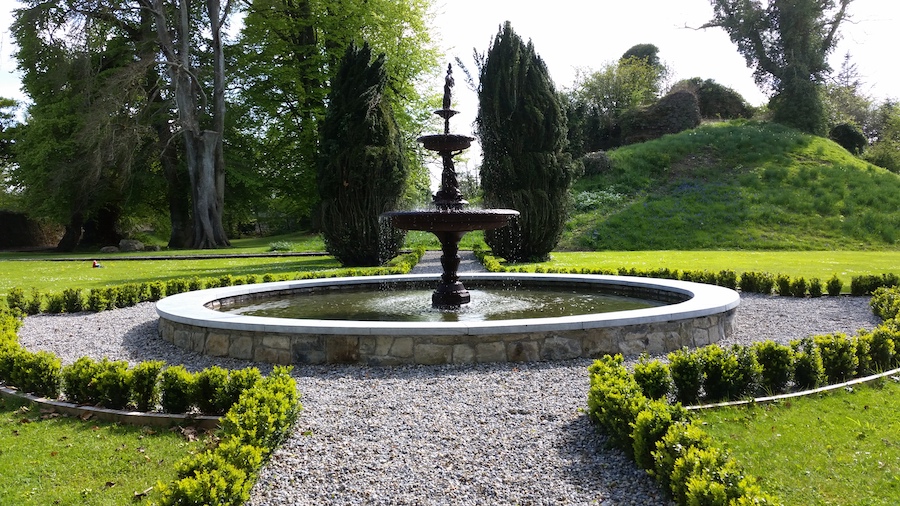
Moyaliffe House Fountain Garden. Photo Lorna Vallely
During this time, we have seen the renovation of Moyaliffe’s former female servants’ quarters into a new guest accommodation wing. In the 1800s, the male and female servants were separated with the male servants enjoying privileges not provided to the females. For example, the males had use of an indoor flushing toilet! Not the girls! The very sad fact was that this profound degree of discriminatory treatment continued at Moyaliffe until the mid-1900s.
The garden suite
Quite unlike the method of furnishing the original servants’ quarters, the new guest wing was furnished through a last-minute dash to Ikea, and then subsequently christened ‘The Garden Suite’. This was partly because of the floral theme evident with our purchasing (I could hardly imagine the initial owners of Moyaliffe House calling their servants quarters, the Garden Suite).
The other reason for the name, are the glorious views offered towards the gardens. For instance, the simple pleasure derived from climbing the new timber staircase and looking out over the fountain garden from the top floor is immense. How fortunate to have reopened a window long bricked up as it faces east and floods the lounge room with soft, early morning light. The new window frames the view of a crabapple and magnolia below, glorious in Spring with soft pink blooms, with the fountain garden lined with Buxus sempervirens beyond.
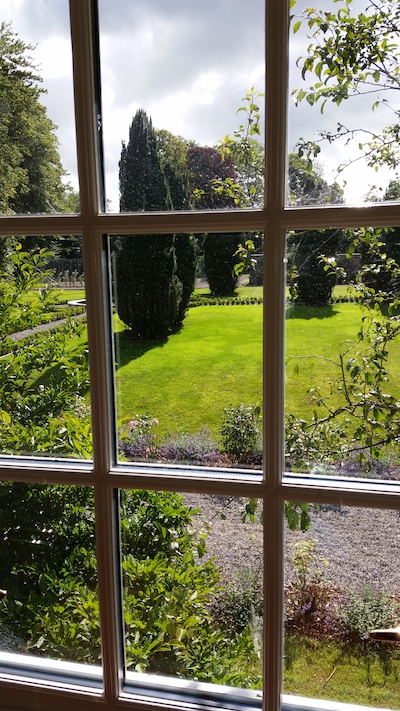
A room with a view. Photo Lorna Vallely
Box blight
The threat of box blight hangs heavy in Ireland and a recent visit to a client’s garden showed how nasty a disease it can be. Many of her box plants had suffered blight, with whole sections defoliating, so unsightly patches of brown twigs are all that remain.
Treatment is prolonged and often results in no improvement so the plants have to be removed. And begs the question, what plants are a suitable substitute? There are alternatives but none give quite the same bright green new growth and are so pleasing to the eye. Having planted about 550 of them, I want to keep them healthy so allowing plenty of air flow around them, fertiliser in Spring and a single pruning around the end of July should help ward off the beast that is blight.
The walled garden
At about two acres in size, we have a relatively large walled garden as most in Ireland are about an acre in size. A lot of space to fill! The plan I drew up was to include ornamental gardens as well as productive gardens as originally this is how the garden was used.
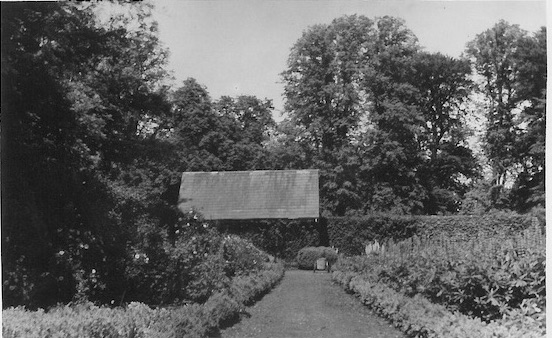
Inspiration was found in the old photographs of the garden taken about 1900, which we are so fortunate to have.
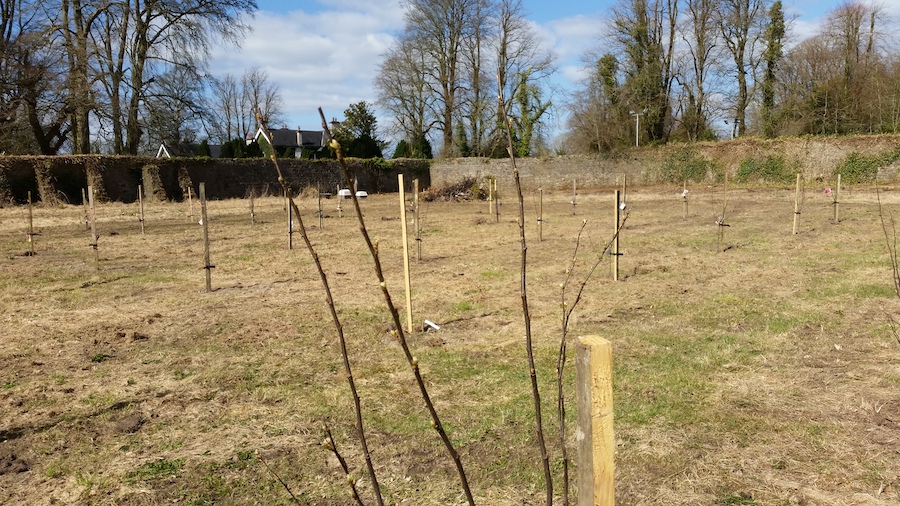
Fruit trees planted in March 2020. Photo Lorna Vallely
Everything in there, including a substantial apple house constructed of brick, was razed to the ground in the 1980s to make way for grazing cows! In mid-March we planted 45 fruit trees including apples, pears, quinces, plums and mulberries. And suddenly it looked right! Those rows of trees lent it a look of neat horticultural endeavour and we were smitten!
Soon to follow was a large potato planting of ‘early’ British Queens and ‘late’ Red Rooster potatoes (in Ireland, one does not just say ‘potato’, but reverently declares also the variety), lettuce, spinach, cauliflowers, onions, beetroot and carrots. The vegetable patch was thirsty and due to the very mild spring, water became an issue. We soon realised that we needed an independent supply other than the well supply as water tests revealed calcium levels three times higher than normal. Hence why racehorses are bred so successfully in Co. Tipperary! Strong bones from all that calcium.
After some consultation we installed a pump and holding tank next to the river, sank a trench from there uphill to the walled garden and are now pumping water from the river to the garden. It makes you wonder how it was watered 100 years ago. But then there were four full time gardeners on the estate!
Wall repairs
The other issue was the state of repair of the wall itself, especially close to where the glasshouse was to be constructed. Earlier we had a Heritage Building consultant give us advice regarding the wall. There was a very worrying bowing inwards of the wall of a section about 10 metres in length so we made the decision to knock it down and rebuild it to ensure its structural integrity. It was quite a day when we knocked that section of wall as it had stood for about 180 years! Once that was completed in accordance with the plethora of requirements needed for heritage compliance, it was all go with the building of the glasshouse. The first sods were lifted in mid-April 2020 and foundations laid. A very lucky find were the original stone slabs from the apple house so these were reused to floor the glasshouse, something that gave us great satisfaction. It is a lovely link to the old building that we have seen only in old photographs of the garden.
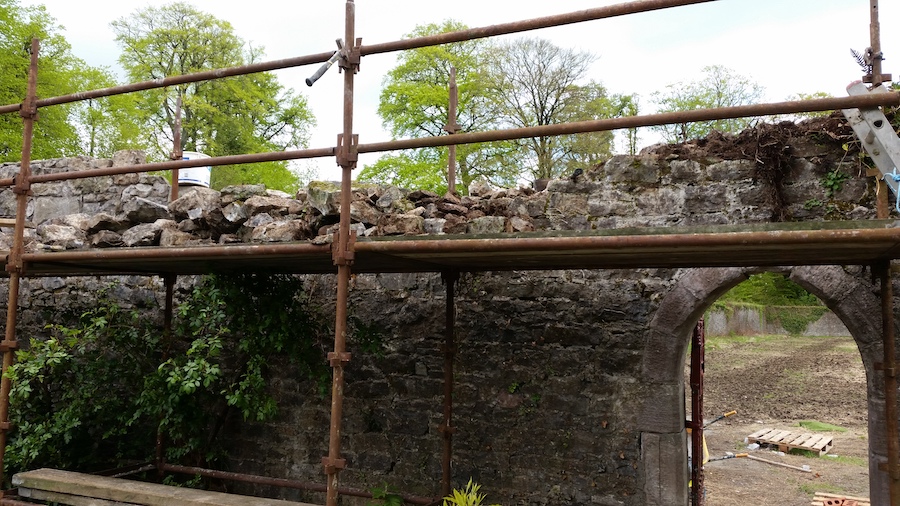
Repairing the wall at Moyaliffe House. Photo, Lorna Vallely
May was a beautiful Spring month with warm, calm days. The timber frame for the glasshouse went up, the previously unseen Rhododendrons and peony roses were in bloom and more wall was being repaired. In June we hired a cherry picker to trim the Yew trees, all 12 of them!
The glass for the glasshouse was finally installed in August, with some minor additions so that by mid-September it was finished and receiving its first occupants, Salvias! A huge milestone in the life of the walled garden.
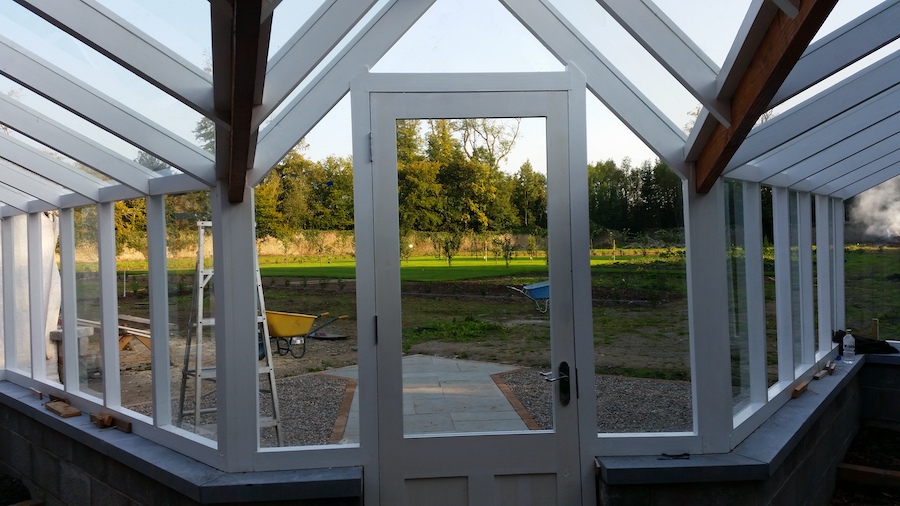
The glasshouse takes shape. Photo Lorna Vallely.
A herb garden was planted beside it and 15 cherry trees, five hazelnuts and a walnut tree planted in the orchard. The hazels will have to be guarded against squirrel raids as they like them very much. Red squirrels are now frequently seen in the grounds and are a delight.
Further planting of hedging to divide the orchard from the ornamental gardens has taken place so the shape of things to come is a little clearer.
The ornamental gardens are designed as garden rooms, each with a different theme. The Australian garden should be an interesting challenge in Ireland. The stunning Dicksonia antarctica will be featured as they grow well here in the mild, wet climate so long as they have protection from frost. Mounding and addition of plenty of sand are other methods to ensure drainage for those Aussie natives.
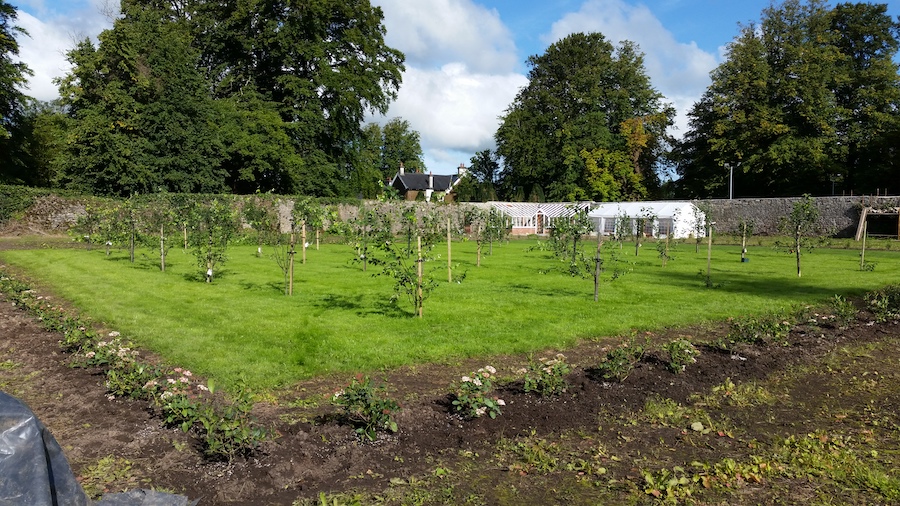
Spring growth. Photo Lorna Vallely
In April 2021 we are planning an open day at Moyaliffe to give locals and others a chance to see the gardens as they progress. Let’s hope they agree that Moyaliffe is being restored to something of its former glory. It will also be such a relief if by that time, we are free to meet and mingle with each other once again – and what better place to reconnect than in someone’s garden.
